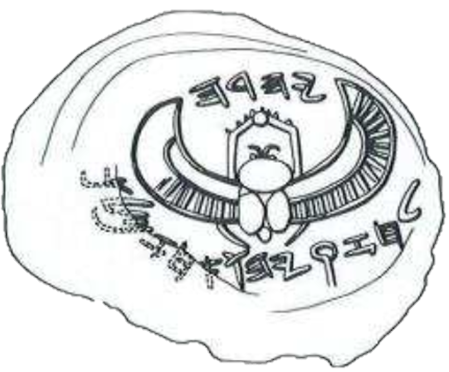Things with Wings
The IAA (Israel Antiquities Authority) publicized today a cool seal from the time of the First Temple recently found near Wilson's Arch in Yerushalayim. The seal features an Assyrian-style winged figure and the name of one Yehoezer ben Hoshayahu.
(the newly-discovered seal; image taken from here)
The figure on the seal is usually interpreted as a "daemon" or "genius", a kind of mythological guardian figure from Assyria. This is far from the first time mythological figures and creatures have been found on Israelite and Judahite seals and bullae. In fact, even King Chizkiyahu (Hezekiah)'s bullae feature a variety of Egyptian mythological entities, including a scarab, a winged sun disk, and an Egyptian-style winged figure.
(Chizkiyahu bulla w/ winged sun disk and ankhs from Elat Mazar's Ophel Excavations)
(Chizkiyahu bulla w/ scarab from private collection)
(Chizkiyahu bulla w/ winged figure and ankh symbol from private collection)
I'm sure that some people would regard such symbols as being related to idolatrous beliefs and practices held by Israelites and Judahites when they were considered sinful (e.g. practically every book in the Nevi'im...). However, I'm not sure this could ever explain why such symbols appear on Chizkiyahu's bullae, when we know that he was one of the most God-fearing of the kings (this is also evident in various archeological findings, perhaps a topic for another post). Some, perhaps, may try to argue that these bullae were made when Chizkiyahu was prince, and don't reflect his religious transformation when he became king. However, the bullae clearly title him מלך יהדה (Melech Yehudah, King of Judah), so that can't be it.
There are various other explanations, such as common Judahite reinterpretation of pagan symbols in various manners. The ankh is explained as simply a symbol promising long life (like a Chai חי necklace or something). Other symbols may have redemption and/or liberty-related meanings. One of my professors commented that none of these could ever be proven (unless we find an ancient text that states so explicitly, of course). As for myself, I've sometimes wondered whether Chizkiyahu - and by extension, other Israelites and Judahites - believed these images symbolized angels. Again, this probably can't be proven, but it seems like a better interpretation than what is consensus in the more minimalistic side of the spectrum, which is that there was a common milieu of symbols in the Levant and the Israelites/Judahites weren't wholly bothered by what seem to us today to being pagan symbols. Some may compare this to the Helios-like figure in the Zodiac wheels found on several shul (synagogue) mosaic floors in Israel, dated to the Byzantine period. I'm uncomfortable with such explanations, so I'll stick to it either being a mystery, or related to angels for the time being. Let's hope a good explanation will surface in the future.




Comments
Post a Comment